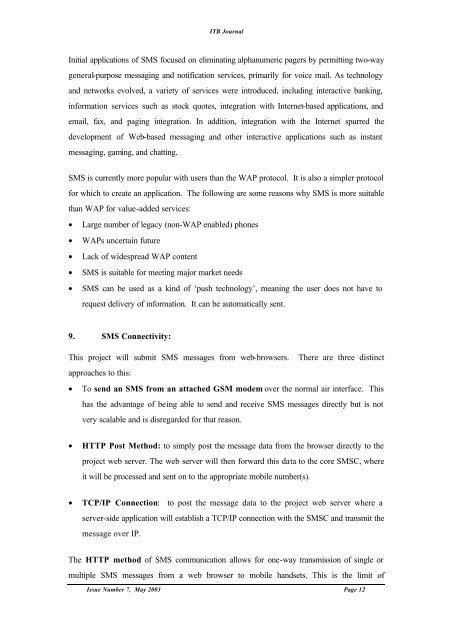ITB Journal-May-2003 - Institute of Technology Blanchardstown
ITB Journal-May-2003 - Institute of Technology Blanchardstown
ITB Journal-May-2003 - Institute of Technology Blanchardstown
Create successful ePaper yourself
Turn your PDF publications into a flip-book with our unique Google optimized e-Paper software.
<strong>ITB</strong> <strong>Journal</strong><br />
Initial applications <strong>of</strong> SMS focused on eliminating alphanumeric pagers by permitting two-way<br />
general-purpose messaging and notification services, primarily for voice mail. As technology<br />
and networks evolved, a variety <strong>of</strong> services were introduced, including interactive banking,<br />
information services such as stock quotes, integration with Internet-based applications, and<br />
email, fax, and paging integration. In addition, integration with the Internet spurred the<br />
development <strong>of</strong> Web-based messaging and other interactive applications such as instant<br />
messaging, gaming, and chatting.<br />
SMS is currently more popular with users than the WAP protocol. It is also a simpler protocol<br />
for which to create an application. The following are some reasons why SMS is more suitable<br />
than WAP for value-added services:<br />
• Large number <strong>of</strong> legacy (non-WAP enabled) phones<br />
• WAPs uncertain future<br />
• Lack <strong>of</strong> widespread WAP content<br />
• SMS is suitable for meeting major market needs<br />
• SMS can be used as a kind <strong>of</strong> ‘push technology’, meaning the user does not have to<br />
request delivery <strong>of</strong> information. It can be automatically sent.<br />
9. SMS Connectivity:<br />
This project will submit SMS messages from web-browsers. There are three distinct<br />
approaches to this:<br />
• To send an SMS from an attached GSM modem over the normal air interface. This<br />
has the advantage <strong>of</strong> being able to send and receive SMS messages directly but is not<br />
very scalable and is disregarded for that reason.<br />
• HTTP Post Method: to simply post the message data from the browser directly to the<br />
project web server. The web server will then forward this data to the core SMSC, where<br />
it will be processed and sent on to the appropriate mobile number(s).<br />
• TCP/IP Connection: to post the message data to the project web server where a<br />
server-side application will establish a TCP/IP connection with the SMSC and transmit the<br />
message over IP.<br />
The HTTP method <strong>of</strong> SMS communication allows for one-way transmission <strong>of</strong> single or<br />
multiple SMS messages from a web browser to mobile handsets. This is the limit <strong>of</strong><br />
Issue Number 7, <strong>May</strong> <strong>2003</strong> Page 12
















